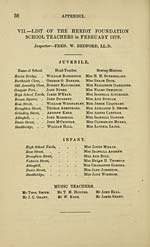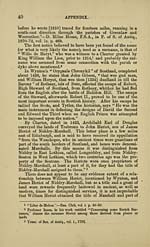Download files
Complete book:
Individual page:
Thumbnail gallery: Grid view | List view

HISTORICAL AND GENEALOGICAL NOTES. 39
VIII. -COLLECTIONS, AND NOTES, HISTORICAL
AND GENEALOGICAL, REGARDING THE
HERIOTS OF TRABROUN.
INTRODUCTION.
The derivation of the word " Heriot " is given in Jamieson's
Scottish Dictionary (Longmuir's edition) thus : — " Heriot : The
fine exacted by a superior on the death of his tenant. From
Anglo-Sanon heregeat, compounded of here exercitus and geat-an,
reddere, erogare. This primarily signified the tribute given to
the lord of the manor for his better preparation for war; but came
at length to denote the best aucht, or beast of whatever kind,
which a tenant died possessed of, due to his superior after
death. It is therefore the same with the English forensic term
Heriot. Here we have the meaning of the surname of George
Heriot."
There is a parish, and a river in it, both of the name of
Heriot, about twenty miles south-east of Edinburgh ; also a small
stream of the name in the parish of Cockburnspath, Ber-
wickshire ; but how_ the name came to be applied to any of
them does not appear to be ascertained. Chalmers, in his
" Caledonia," says — " The origin of the singular name of this
parish is uncertain. Heriot, probably, is neither the original
name of the water (river), nor a descriptive appellation of the
place. . . . Heriet is the spelling in the ancient Taxalio ; "
and he states his opinion to be that the name is derived from
Hergeath in the Anglo-Saxon, signifying "an invasion — a
spoliation."
There is likewise " a very old artificial mound or embank-
ment called Herit's Dyke 1 mentioned by Chalmers, and also in
the statistical accounts of the parishes. It is supposed to have
been erected by the Romanised Ottadini. Perhaps this dyke
was not intended to be a military work ; it may only have been
a boundary fence separating one large district of country from
another. This embankment, Chalmers says, had been, shortly
1 The Dyke is called Harriot's in the Statistical Account of the Parish of
Greenlaw, and Barit's in that of Westruther. It may be noticed that Sir
Walter Scott, in a note to his "Provincial Antiquities" (Edition 1853,
p. 253) says — "The learned William Hamper, of Birmingham, has suffi-
ciently proved that the word Hare or Har refers to a boundary."
VIII. -COLLECTIONS, AND NOTES, HISTORICAL
AND GENEALOGICAL, REGARDING THE
HERIOTS OF TRABROUN.
INTRODUCTION.
The derivation of the word " Heriot " is given in Jamieson's
Scottish Dictionary (Longmuir's edition) thus : — " Heriot : The
fine exacted by a superior on the death of his tenant. From
Anglo-Sanon heregeat, compounded of here exercitus and geat-an,
reddere, erogare. This primarily signified the tribute given to
the lord of the manor for his better preparation for war; but came
at length to denote the best aucht, or beast of whatever kind,
which a tenant died possessed of, due to his superior after
death. It is therefore the same with the English forensic term
Heriot. Here we have the meaning of the surname of George
Heriot."
There is a parish, and a river in it, both of the name of
Heriot, about twenty miles south-east of Edinburgh ; also a small
stream of the name in the parish of Cockburnspath, Ber-
wickshire ; but how_ the name came to be applied to any of
them does not appear to be ascertained. Chalmers, in his
" Caledonia," says — " The origin of the singular name of this
parish is uncertain. Heriot, probably, is neither the original
name of the water (river), nor a descriptive appellation of the
place. . . . Heriet is the spelling in the ancient Taxalio ; "
and he states his opinion to be that the name is derived from
Hergeath in the Anglo-Saxon, signifying "an invasion — a
spoliation."
There is likewise " a very old artificial mound or embank-
ment called Herit's Dyke 1 mentioned by Chalmers, and also in
the statistical accounts of the parishes. It is supposed to have
been erected by the Romanised Ottadini. Perhaps this dyke
was not intended to be a military work ; it may only have been
a boundary fence separating one large district of country from
another. This embankment, Chalmers says, had been, shortly
1 The Dyke is called Harriot's in the Statistical Account of the Parish of
Greenlaw, and Barit's in that of Westruther. It may be noticed that Sir
Walter Scott, in a note to his "Provincial Antiquities" (Edition 1853,
p. 253) says — "The learned William Hamper, of Birmingham, has suffi-
ciently proved that the word Hare or Har refers to a boundary."
Set display mode to:
![]() Universal Viewer |
Universal Viewer | ![]() Mirador |
Large image | Transcription
Mirador |
Large image | Transcription
Images and transcriptions on this page, including medium image downloads, may be used under the Creative Commons Attribution 4.0 International Licence unless otherwise stated. ![]()
| Histories of Scottish families > Supplement to third edition of History of George Heriot's Hospital > (55) Page 39 |
|---|
| Permanent URL | https://digital.nls.uk/94963770 |
|---|
| Description | A selection of almost 400 printed items relating to the history of Scottish families, mostly dating from the 19th and early 20th centuries. Includes memoirs, genealogies and clan histories, with a few produced by emigrant families. The earliest family history goes back to AD 916. |
|---|

